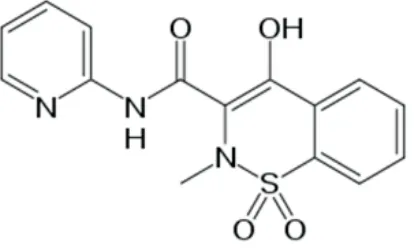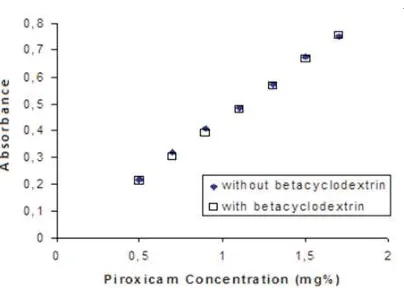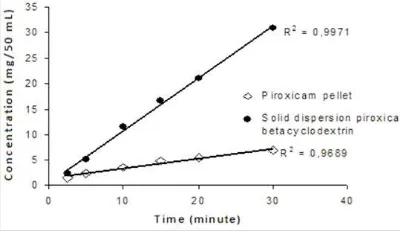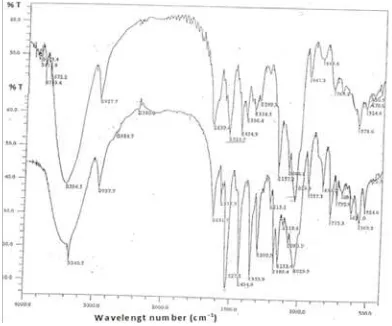ENHANCEMENT OF PIROXICAM INTRINSIC DISSOLUTION
RATE WITH SOLID DISPERSION SYSTEM USING BETA
CYCLODEXTRIN
Setyo budiarto1, Annas Binarjo2* Ifars Pharmaceutical Industry, Surakarta
Abstract
Objective: This research was aimed to increase the intrinsic dissolution rate (IDR) of piroxicam with solid dispersion system of piroxicam-betacyclodextrin (SDSPB). This system can overcome the dissolution problem of piroxicam.
Method: Determination of piroxicam IDR was performed using intrinsic dissolution tester in 100 rpm speed of stir. Free CO2 water was used as solvent. Piroxicam concentration in was measured using spectrophometer. The piroxicam IDR of SDSPB which was prepared using solvent method with freeze drying was compared with control (piroxicam alone). Then the interaction of piroxicam with betacyclodextrin was analyzed using IR spectra.
Result:The IDR of SDSPB and piroxicam pellet are 1.2247 and 0.244 mgcm-2minute-1 respectively. This enhancement was predicted due to inclusion complex and electrostatic interaction of piroxicam and betacyclodextrin.
Conclusion: The SDSPB can enhance six times fold of piroxicam IDR (p£0,05). The researches purposed to formulate SDSPB tablet and to test its bioavailability are needed to confirms this IDR enhancement.
Keywords : piroxicam, cyclodextrin, solid dispersion, inclusion complex
2Faculty of Pharmacy, Ahmad Dahlan University, Yogyakarta
INTRODUCTION
Absorption process in gastrointestinal is simplified in two steps. Firstly, the dissolution in gastrointestinal medium and secondly, permeation trough gastrointestinal membrane to reach blood in capilar of venaporta hepatica (Shargel et al, 2005). The poor water solubility drugs have dissolution problem since the gastrointestinal medium consist of water dominantly. Thus to overcome this problem many pharmaceutical technology including micronization, formation of complexes (Perrut, 2003) and solid dispersions (Ruan et al, 2005; Chiou and Riegelman, 1971) are developed. The solid dispersion system are being the focused of recent studies (Serajudin, 1999; Sethia and Squilante, 2003) and several successful products have been commercialized in pharmaceutical market.
In solid dispersion system, the very fine drug particle is dispersed in solid water soluble carrier, i.e. PVP (polyvinyl pirolidone), PEG (polyetilen glykol), urea, and cyclodextrin (Chiou and Riegelman, 1971). This system can be prepared by melting (fusion) method or solvent evaporation method (Habib, 2001), or combination (Chiou and Riegelman, 1971, Dabbagh and Taghipour, 2007). In fusion method, the physical mixture of drug and carrier is heated in high temperature (about 150oC, depend on their melting point) to reach liquid state, and then it is cooled quickly to get solid dispersion. Because of this high temperature, many drugs degrade (Chiou and Rigelman, 1971). In solvent method the physical mixture of drug and carrier was dilute in evaporable semipolar solvent, since the drug is water insoluble and the carrier is water soluble, and the solvent must be evaporated in low temperature (Chiou and Riegelman, 1971). Some solvent are selected i.e. acetone (Al-Obaidi et al, 2009), ethanol, and water (Al-Hamidi et al, 2010).
Some approaches are used to concluded
bioavailability (Tianti et al, 2005), etc. In IDR determination, the dissolution rate of pellet solid dispersion is measured in constant surface area, and IDR is defined as rate of dissolution divided by surface area. If the IDR is more than 1 mg/cm2/minute, this drug has no problem on dissolution in gastrointestinal medium. Generally this drug has more than 1% water solubility (Shargel and Yu, 1985).
Piroxicam (figure 1) is an NSAIDs which has poor solubility (23 mg/L). It is a weak acid with pKa 6,3 (Anonym, 2012). From its water solubility, it is predicted that piroxicam has problem on dissolution in gastrointestinal medium. This research was aimed to overcome this problem via solid dispersion system using betacyclodextrin, and to prove this advantage by measured its IDR.
MATERIAL AND METHOD
Material
The piroxicam was purchased from PT Indofarma Tbk Bekasi (Dinamite Dipharma S.p.A). Betacyclodextrin (Sigma) was p.a degree. Another reagent i.e. sodium hydroxide, Ammonia, and KBr have p.a degree, produced by E Merck. Intrinsic Dissolution Tester designed by Yuwono was produced by T&A
was used to record solid dispersion system IR spectrum.
Method
Contruction of Calibration Curve
The piroxicam solution (1,1 mg%) was scanned in 200-400 nm of wave length to get maximum absorbance wave length (ëmax). The absorbance of piroxicam solution in various concentration (0.5; 0.7; 0.9; 1.1; 1.3; and 1.7 mg%) with and without betacyclodextrin in the same concentration were measured their absorbance at ëmax. The linear regression of piroxicam absorbance as the function of concentration with and without betacyclodetrin were used to calculate the concentration of piroxicam released from their pellets in IDR test.
Preparation of Piroxicam-Betacyclodextrin Solid Dispersion
The piroxicam-Betacyclodextrin Solid Dispersion System was prepared using solvent method. Equimol Physical mixture of piroxicam and betacyclodextrin was dilute in minimum volume of ammonia solution 25%, the solution was frezzed. Then the solvent was evaporated using freeze dryer (Modulyo). Next, the KBr powder was added to the solid dispersion. This mixture was pressed on 2 tons weight for 5 minute to get KBr pellet for IR Spectrum Characterization. The same pellet without KBr was made to use in IDR test. These pellets have 1,8 cm in diameter and about 200 mg of powder was needed.
IDR Determination.
The pellet of piroxicam (or solid dispersion of piroxicam-betacyclodextrin) was set up in IDR tester. Accurate volume of free CO2 aquadest (50,0 mL), as solvent, was maintained its temperature in 37oC using thermostat. The pellet in IDR tester was brought in this medium, then the time was started, the IDR tester was connected to rotor, and it was
rotated 100 rpm. Accurate volume of sample (3,0 mL) was taken out from medium and the equal volume of fresh medium was added to maintain the volume. The sampling time was scheduled at 2.5, 5, 10, 15, 20, 30, and 45 minutes. The concentration of piroxicam in the
sample was determined using
spectrophotometric method. IDR is defined as rate of dissolution per surface area. It can be calculated from the slope of curve of time of dissolution versus amount of drug dissolved per surface area (W/A).
RESULT
Calibration Curve of Piroxicam in Water Piroxicam solution in water has ëmax of
354,8 nm, both with and without
betacyclodextrin. Figure 2 shows calibration curve of piroxicam in water. These two line are identical, and have no significant differences (p>0,05). It can be concluded that betacyclodextrin do not change the lambda max and absorbance, so that one of these two calibration curve can be selected to calculate piroxicam concentration of sample from IDR test of solid dispersion system piroxicam-betacyclodextrin pellet or piroxicam pellet
Figure 2. Calibration curve of piroxicam with betacyclodextrin (y=0.4532x – 0.01653) and without
IDR Determination
Concentration of piroxicam release from piroxicam pellet and solid dispersion system of piroxicam-betacyclodextrin pellet are shown in figure 3. In dissolution test, “sink condition” is required, it means that the bulk concentration must be lower than 1/10 of its solubility. This condition is shown by linear curve between concentration as the function of time. From figure 3, it can be concluded that during 30 minutes of dissolution the sink condition is appear, because of its high R2. Thus the data can be proceeded to calculate IDR.
The linear equation in figure 4 shows that solid dispersion system could enhance IDR six times fold from control. IDR of piroxicam from solid dispersion is 1.225 mg cm-2menit-1. Thus this system showed that piroxicam had no problem in dissolution in gastrointestinal medium.
Prediction of Interaction between Piroxicam and Cyclodextrin
The interaction between piroxicam and betacyclodextrin was predicted based on computer software analyzed (HiperChem) and FTIR spectra. From the molecule structure of piroxicam and betacyclodextrin, it is predicted that piroxicam can be entrapped into the hollow space of betacyclodextrin as shown in figure 5. This constructure is called inclusion complex, and since betacyclodextrin has the high water solubility, the piroxicam entrapped will be pulled to dissolve.
Figure 3. Identification of sink condition
A B
C D
Figure 5. HiperChem prediction of interaction between piroxicam and betacyclodextrin. A: Piroxicam structure,
B: Betacyclodetrin structure, C: Side view of Piroxicam (purple) entrapped in betacyclodextrin (green), D:Front view of Piroxicam (purple) entrapped in betacyclodextrin
FTIR spectra of piroxicam, betacyclodextrin, physical mixture of piroxica-betacyclodextrin, and solid dispersion system of piroxicam-betacyclodextrin are shown in figure 6, 7, and 8 respectively. Solid dispersion system of piroxicam-betacyclodextrin has FTIR spectra differ with its physical mixture. In wavelength number between 1550 cm-1 to 1000 cm-1, the solid dispersion system has less intensity than its physical mixture. This is because of electrostatic
interaction between piroxicam and
betacyclodextrin. The disappearing of S=O (1184.2) and NH amine (1577.7) in solid dispersion system indicated that electrostatic bound was formed between those functional group. The electron delocalization in piroxicam formed positive and negative pole as shown in figure 9. The dispute of electronegativity between H and O in betacyclodextrin formed positive partial and negative partial as shown in figure 9. The positive pole of piroxicam can interact with the negative partial of betacyclodextrin, while the negative pole of piroxicam can interact with positive partial of betacyclodextrin.
DISCUSION
This study shows that the solid dispersion system of piroxicam-betacyclodextrin could enhances the IDR of piroxicam. Since piroxicam has dissolution as absorption rate limiting step, the increasing of IDR could overcome the
Figure 7. FTIR spectra of betacyclodextrin in pellet KBr
Figure 8. Super impose of FTIR spectra of piroxicam-betacyclodextrin physical mixture of and solid
dispersion system of piroxicam and betacyclodextrin.
problem of piroxicam absorbtion. It was predicted that the interaction between piroxicam-betacyclodextrin in solid dispersion system will involve the inclusion and electrostatic complex.
Our result is consistent with the previous study about overcoming the piroxicam dissolution problem. Verma et al (2003) could overcome the dissolution problem of piroxicam by forming the nicotinamide-piroxicam solid dispersion using fusion method. Another studies are listed in table I.
Betacyclodextrin as a carrier for solid dispersion system has succeeded to enhance the dissolution of many drugs (Table 2). The hollow structure is responsible on this ability via inclusion complex.
CONCLUSION
Solid dispersion system of
piroxicam-betacyclodextrin enhances the IDR of piroxicam. It is predicted that the interaction between piroxicam and betacyclodextrin in solid dispersion system involve inclusion complex and electrostatic complex. The researches purposed to formulate SDSPB tablet and to test its bioavailability are needed to confirms this IDR enhancement.
ACKNOWLEDGMENT
The author would like to thank to Dr. Tedjo Yuwono who has found time to discus about this research.
Carrier/complexing agent Method of solid dispersion
development References
polyvinylpyrrolidone (PVP) K-17 PF, PVP K-90 PEG4000, urea
polyethylene glycol 400, polyvinyl pyrolidone K-30 microcrystalline cellulose, potato starch
myrj 52, Eudragit® E100, mannitol
Polyvinylpyrrolidone
Solvent method
fusion and solvent methods Solvent method
Solvent method
Solvent method, precipitation method
Antisolvent precipitation, spray drying techniques
Tantishaiyakul et al, 1999
Pan et al, 2000 Patel et al, 2003
Charumanee et al, 2004
Valizadeh et al, 2007
Wu et al, 2008
Table I. Some effort to overcome piroxicam dissolution problem
Drugs Method of solid dispersion
development references
Nagarsenker et al, 2000 Balata et al, 2010 Swami, et al, 2010 Nagesh et al, 2011
REFERENCES
Al-Hamidi H, Edwards AA, Mohammad MA,
Nokhodchi A, 2010, To Enhance Dissolution Rate Of Poorly Water-Soluble Drugs: Glucosamine Hydrochloride As A Potential Carrier In Solid Dispersion
Formulations, Colloids Surf B
Biointerface,76(1):170-178
Al-Obaidi H, Brocchini S, and Buckton G, 2009, Anomalous Properties Of Spray Dried Solid
Dispersions,J.Pharm. Sci.,98(12):4724-4737
Anonym, 2012,
http://www.drugbank.ca/drugs/DB00554, accessed in May 2012
Balata G, Mahdi M, Bakera RA, 2010, Improvement of solubility and dissolution properties of ketoconazole by solid dispersions and inclusion complexes,
AJPS, 5 (1):1-12.
Charumanee S, Okonoki S, and Sirithunyalug J, 2004, Improvement of the Dissolution Rate of Piroxicam by Surface Solid Dispersion,CMU. Journal,. 3(2):77-85 Chiou WL, Riegelman S, 1971, Pharmaceutical
Applications Of Solid Dispersion Systems.J Pharm Sci., 60:1281–1302 Dabbagh MA and Taghipour B, 2007,
Investigation Of Solid Dispersion
Technique In Improvement Of
Physicochemical Characteristics Of Ibuprofen Powder,Iranian J. Pharm. Sci., 3:69-76.
Habib MJ, 2001, Pharmaceutical Solid
Dispersion Technology, Ed III,
Technomic Publishing, Lancaster
Kumar MA, Lakhsmi PK, Giriprasad PS, 2012, Development and Evaluation of Solid Dispersion Formulated Ibuprofen Tablets Using Cyclodextrin Carier, IJPRD, 3(11):93-101
Nagesh C, Vijay K, Venkatesh JS, Shankaraiah mm, Amnt k, 2011, Improving The
Solubility Of Antihelmintic Drug By Solid Dispersion And Inclusion Complex, IRJP, 2(8): 100-104
Pan RN, Chen JH, Chen RR, 2000,
Enhancement of Dissolution and
Bioavailability of Piroxicam in Solid Dispersion Systems, Drug. Dev. Ind. Pharm., 26(9):989-994.
Patel DM, Shah RR, Jogani PD, 2003, Studies To Enhance Dissolution Of Piroxicam, IJPS,65(3):264-267
Perrut M, 2003, Supercritical Fluids Applications In The Pharmaceutical Industry,Stp Pharma Sci, 13:83–91 Punitha S, Karthikeyan D, Devi P, and
Vedha-Hari BN, 2009, Enhancement of Solubility and Dissolution of Celecoxib by Solid Dispersion Technique, JPST, 1(2):63-68
Ruan LP, Yu BY, Fu GM, Zhu DN, 2005, Improving The Solubility Of Ampelopsin By Solid Dispersions And Inclusion Complexes. J.Pharmceut Biomed., 38:457– 464
Serajuddin ATM, 1999, Solid Dispersion Of Poorly Water-Soluble Drugs: Early Promises, Subsequent Problems, And Recent Breakthroughs, J Pharm Sci., 88:1058–1066.
Sethia S, Squillante E, 2003, Solid Dispersions: Revival With Greater Possibilities And Applications In Oral Drug Delivery. Crit Rev Ther Drug, 20, 2003, 215– 247 Shargel, L., Pong, S.W., and Yu. A.B.C., 2005,
Applied Biopharmaceutics and Pharmacokinetics, Ed V, 411-450, The McGraw-Hill, Singapore.
Swami G, Koshy MK, Pandey M, Saraf S, 2010, Preparation And Characterization Of
Domperidone- Â-Cyclodextrin
Complexes Prepared By Kneading
Method, Int J Pharm Pharm Sci, 1:68-74.
Tantishaiyaku V, Kaewnopparat N,
Soliddispersions Of Piroxicam In Polyvinylpyrrolidone, Int J Pham,
181(2):143–151
Tianti E, Binarjo A, and Yuwono T, 2005, Ketersediaan Hayati Dispersi Padat FurosemidDengan Polietilenglikol 4000 (PEG 4000) Pada Kelinci Jantan, MFI, 16(2), 1124 – 129,
Valizadeh H, Zakeri-Milani P, Barzegar-Jalali
M, Mohammadi G, Bahreini MAD,
Adibkia K, and Nokhodchi A, 2007, Preparation and Characterization of Solid
Dispersions of Piroxicam with
Hydrophilic Carriers, Drug Dev Ind Pharm., 33(1):45-56.
Verma MM, Kumar MT, Balasubramaniam J,
Pandit JK. 2003, Dissolution, Bioavailability And Ulcerogenic Studies On Piroxicam-Nicotinamide Solid Dispersion Formulations. Boll Chim Farm,142(3):119-124.
Wu K, Li J, Wang W, Winstead DA, 2009, Formation and Characterization of Solid
Dispersions of Piroxicam and




